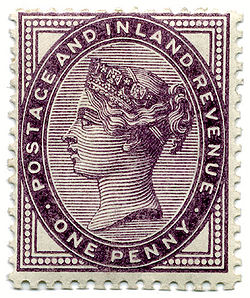
An overprint is an additional layer of text or graphics added to the face of a postage or revenue stamp, postal stationery, banknote or ticket after it has been printed. Post offices most often use overprints for internal administrative purposes such as accounting but they are also employed in public mail. Well-recognized varieties include commemorative overprints which are produced for their public appeal and command significant interest in the field of philately.

The Penny Black was the world's first adhesive postage stamp used in a public postal system. It was first issued in the United Kingdom on 1 May 1840 but was not valid for use until 6 May. The stamp features a profile of Queen Victoria.

The Penny Red was a British postage stamp, issued in 1841. It succeeded the Penny Black and continued as the main type of postage stamp in the United Kingdom of Great Britain and Ireland until 1879, with only minor changes to the design during that time. The colour was changed from black to red because of difficulty in seeing a cancellation mark on the Penny Black; a black cancellation mark was readily visible on a Penny Red.

Postage stamps and postal history of Great Britain surveys postal history from the United Kingdom and the postage stamps issued by that country and its various historical territories until the present day.

This is a survey of the postage stamps and postal history of Jamaica.

The Penny Venetian Red was a British postage stamp equal to the value of one penny. Issued in 1880, it was designed and surface-printed by security printing company De La Rue. It superseded the Penny Red, which had been used in Great Britain since 1841, and was the third one-penny stamp to enter regular usage in the country.

The Lilac and Green issue is a series of postage and revenue stamps issued in the United Kingdom in 1883 and 1884. The stamps are known as such because they were only printed in those two colours; lilac being used for the 1+1⁄2d, 2d, 2+1⁄2d, 3d values and dull green for the 4d, 5d, 6d, 9d and 1s.

Victoria, a state of Australia and until 1901 a British colony, was still under the control of New South Wales when its first post office was opened in Melbourne in April 1837. Post offices opened at Geelong and Portland soon after, and by 1850 there were forty-five post offices.
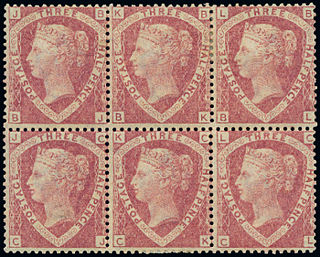
The Three Halfpence Red, first issued on 1 October 1870, was the first Three Halfpenny postage stamp issued in the United Kingdom.

Revenue stamps of Malta were first issued in 1899, when the islands were a British colony. From that year to 1912, all revenue issues were postage stamps overprinted accordingly, that was either done locally or by De La Rue in London. Postage stamps also became valid for fiscal use in 1913, so no new revenues were issued until 1926–1930, when a series of key type stamps depicting King George V were issued. These exist unappropriated for use as general-duty revenues, or with additional inscriptions indicating a specific use; Applications, Contracts, Registers or Stocks & Shares. The only other revenues after this series were £1 stamps depicting George VI and Elizabeth II. Postage stamps remained valid for fiscal use until at least the 1980s.

Revenue stamps of the United Kingdom refer to the various revenue or fiscal stamps, whether adhesive, directly embossed or otherwise, which were issued by and used in the Kingdom of England, the Kingdom of Great Britain, the United Kingdom of Great Britain and Ireland and the United Kingdom of Great Britain and Northern Ireland, from the late 17th century to the present day.
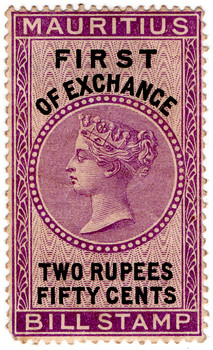
Mauritius issued revenue stamps from 1 March 1869 to 1904. There were various types of fiscal stamps for different uses.

Revenue stamps of British Guiana refer to the various revenue or fiscal stamps, whether adhesive or directly embossed, which were issued by British Guiana prior to the colony's independence as Guyana in 1966. Between the 1860s and 1890s, the colony issued Inland Revenue and Summary Jurisdiction stamps, while revenue stamps and dual-purpose postage and revenue stamps were issued during the late 19th and 20th centuries. In around the 1890s or 1900s, British Guiana possibly issued stamps for taxes on medicine and matches, but it is unclear if these were actually issued. Guyana continued to issue its own revenue stamps after independence.
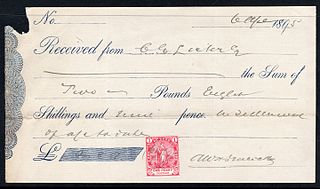
Cape of Good Hope issued revenue stamps from 1864 to 1961. There were a number of different stamps for several taxes.

New Zealand first issued revenue stamps on 1 January 1867 and their general use continued until the early 1950s. The only Revenue Stamp series still in use today is the Game Bird Habitat stamp which is used for payment of the Gun License for the duck shooting season which begins the first weekend of May. There were various types of fiscal stamps for different taxes.
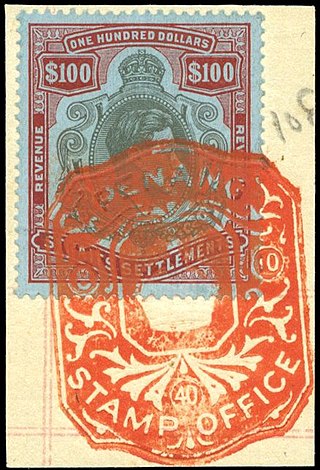
Malaysia first issued revenue stamps as the Straits Settlements in 1863, and continues to do so to this day. Over the years, a number of entities in modern Malaysia have issued revenue stamps.

Canada 12d black or The Black Empress of Canada is the rarest Canadian postage stamp, issued in 1851. The 12-pence stamp shows the portrait of Queen Victoria and is the third stamp issued by the province.
Revenue stamps of Seychelles were first issued in 1893, when the islands were a dependency of the British Crown Colony of Mauritius. The first stamps were Mauritius Internal Revenue stamps depicting Queen Victoria overprinted for use in Seychelles, and Bill stamps were also similarly overprinted. Postage stamps depicting Victoria or Edward VII were overprinted for fiscal use at various points between 1894 and 1904, while surcharges on Bill stamps were made in around 1897–98.
Revenue stamps of Montserrat were first issued in 1866, ten years before the island issued its first postage stamps. The island only issued two different designs of revenue stamps, but postage stamps were widely used for fiscal purposes and are still used as such today.

A postage and revenue stamp, sometimes also called a dual-purpose stamp or a compound stamp, is a stamp which is equally valid for use for postage or revenue purposes. They often but not always bore an inscription such as "Postage and Revenue". Dual-purpose stamps were common in the United Kingdom and the British Empire during the 19th and 20th centuries, and they are still used in some countries as of the early 21st century.
